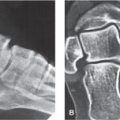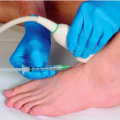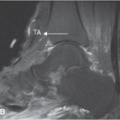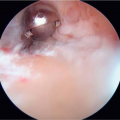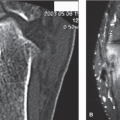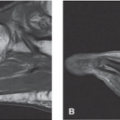Hammer Toe, Claw Toe, and Mallet Toe Pain Syndromes
Anatomic Considerations
The interphalangeal joints of the foot are ginglymoid joints (Fig. 21.1). Each joint has its own capsule. The articular surface of these joints is covered with hyaline cartilage that is susceptible to arthritis. The toe joint capsules are lined with a synovial membrane that attaches to the articular cartilage. The deep transverse ligaments connect the joints of the five toes and provide majority of strength to the toe joints (Fig. 21.2). The muscles of the toe joint and their attaching tendons are susceptible to trauma and to wear and tear from overuse and misuse. These joints are also susceptible to overuse and misuse injuries with resultant inflammation, arthritis, and deformity (Fig. 21.3).
Clinical Correlates
Hammertoe refers to a constellation of symptoms including a painful flexion deformity of the proximal interphalangeal joint with the middle and distal phalanges flexed down onto the proximal phalange. Hammertoe deformity almost always involves the second toe and the condition is almost always bilateral (Figs. 21.4 and 21.5). Significant dorsal corns may develop further exacerbating the deformity (Fig. 21.6). Over time the affected joints may become ankylosed, making the proper fitting of shoes next to impossible (Fig. 21.7). Occurring more commonly in women, like hallux valgus, hammertoe is most commonly the result of wearing shoes with a too-tight toe box, with the wearing of high-heeled shoes exacerbating the problem (Fig. 21.8).
Most patients who present with hammertoe complain of pain localized to the affected proximal interphalangeal joint and of being unable to get shoes to fit. Walking makes the pain worse, with rest and heat providing some relief. The pain is constant and is characterized as aching and may interfere with sleep. Some patients complain of a grating or popping sensation with use of the joint and crepitus may be present on physical examination. In addition to the just-mentioned pain, patients who suffer with hammertoes develop the characteristic hammertoe deformity, which consists of a painful flexion deformity of the proximal interphalangeal joint with the middle and distal phalanges flexed down onto the proximal phalange (Fig. 21.3). Functional disability often accompanies the pain of the hammertoe joint. Patients will often notice increasing difficulty in performing their activities of daily living and tasks that require standing, walking, or weight bearing. If the pathologic process responsible for pain of hammertoe is not adequately treated, the patient’s functional disability may worsen and muscle wasting and ultimately a frozen interphalangeal joint may occur.
Claw toe is a common toe deformity that is the result of hyperextension of the metatarsophalangeal joint with significant flexion at both the proximal and distal interphalangeal joints (Fig. 21.9). Claw toe is a disease of the later decades, occurring five times more frequently in women. Frequently associated with neurologic diseases including Charcot–Marie–Tooth disease, Charcot joint, cerebral palsy, and multiple sclerosis as well as inflammatory arthropathies, if untreated the deformity will become permanent, making wearing shoes difficult if not impossible. Patients suffering from claw toe will complain of pain over the dorsal aspect of the proximal interphalangeal joint, which is raised like a bird’s claw, causing impingement on the top of the shoe. Coexistent pain on the tip of the affected toe is often present as the toe tip is forced against the inside bottom of the shoe. This toe-tip pain is made worse with walking. Callus formation over the points of impingement are common as is nail deformity (Fig. 21.10).
Mallet toe is the result of a flexion contracture of the distal interphalangeal joint, occurring most commonly in the second toe (Figs. 21.3 and 21.11). Causes include hyperextension injuries to the toes which result in avulsion of the distal insertion of the extensor tendon as well as inflammatory arthropathies (Fig. 21.12). The patient will complain of pain at the distal interphalangeal joint and the tip of the toe. As with claw toe, pressure from the inside of the patient’s shoe may cause corn and callus formation as well as pressure ulcers, especially in insensate feet. With time the flexion deformity becomes ankylosed further worsening the pain and deformity. Nail abnormality from constant downward pressure is also a common finding in patients suffering from mallet toe.
Stay updated, free articles. Join our Telegram channel

Full access? Get Clinical Tree


